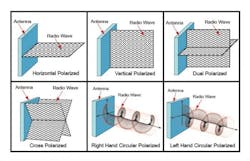What is Antenna Polarization, and Why Does it Matter?
Antenna polarization, much like polarization with light, and nothing to do with arctic weather, and everything to do with the transmission and reception of electromagnetic radiation based on its orientation. With light polarization, a film or glass will appear darker, and block, light which is polarized in a certain direction, while allowing correctly polarized light to pass through. This is similar with an antenna, as the polarization of an antenna will determine how well EM radiation is transmitted or received by that antenna.
Polarization is based on the plane from which the electric field component of the EM radiation is oscillating. If the polarization of the EM wave is offset rotationally from the polarization of an antenna, only a portion of the EM wave will be captured by the antenna. Hence, for optimum efficiency of a communication link, the polarization of the transmitting antenna and receiving antenna should be the same, if the antenna are referenced to the same plane. There are also other physical phenomenon that contribute to the choices of polarization for certain applications.
There are three main types of polarization, with many other possibilities. Typically, RF antenna are either linearly or circularly polarized. Linear polarized antenna are generally either vertically polarized or horizontally polarized, while circularly polarized antenna are either left-hand or right-hand circularly polarized. There is a third common type of polarization, which is a complex combination of both linear and circular polarization, known as elliptical polarization.
Depending on the angle between the polarization vectors of a linearly polarized antenna and an EM wave, the maximum polarization losses of a linearly polarized system are at 45 degrees of each other. At 45 degrees of polarization vector offset, the maximum polarization losses would be 0.5, or 3 dB. For a circularly, and elliptically, polarized system, the calculations are more complex, and the maximum polarization losses can be up to 30 dB. This is why polarization can be used to isolate signals and antenna systems that could interfere with each other. Though there is polarization loss, antennas that are polarized in a different fashion will receive signals from EM waves with different polarization. Hence, there is a limit to the amount of isolation polarization provides.
The polarization of an antenna is most often chosen based on the application requirements. Certain applications benefit from different polarization schemes. For example, vertically polarized antenna may perform better with land-mobile applications, as vertically polarized EM waves tend to travel across the curvature better than horizontally polarized EM waves. Horizontally polarized schemes may perform better when applications that rely on the ionosphere, typically with long distance communication. Lastly, circular polarization is often used in satellite communications, as the circular polarization tends to perform better in mitigating fading caused from shifts in satellite orientation.
